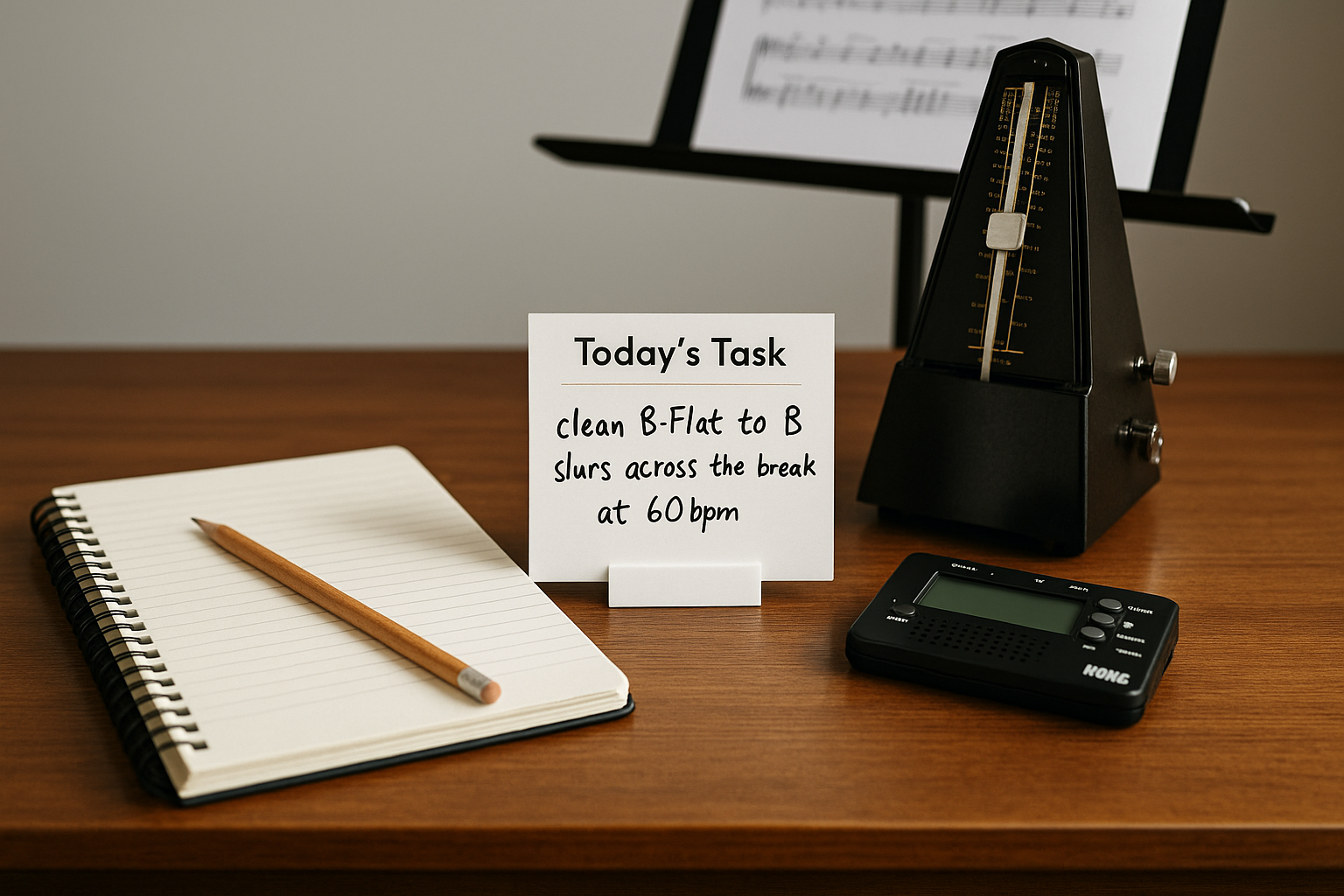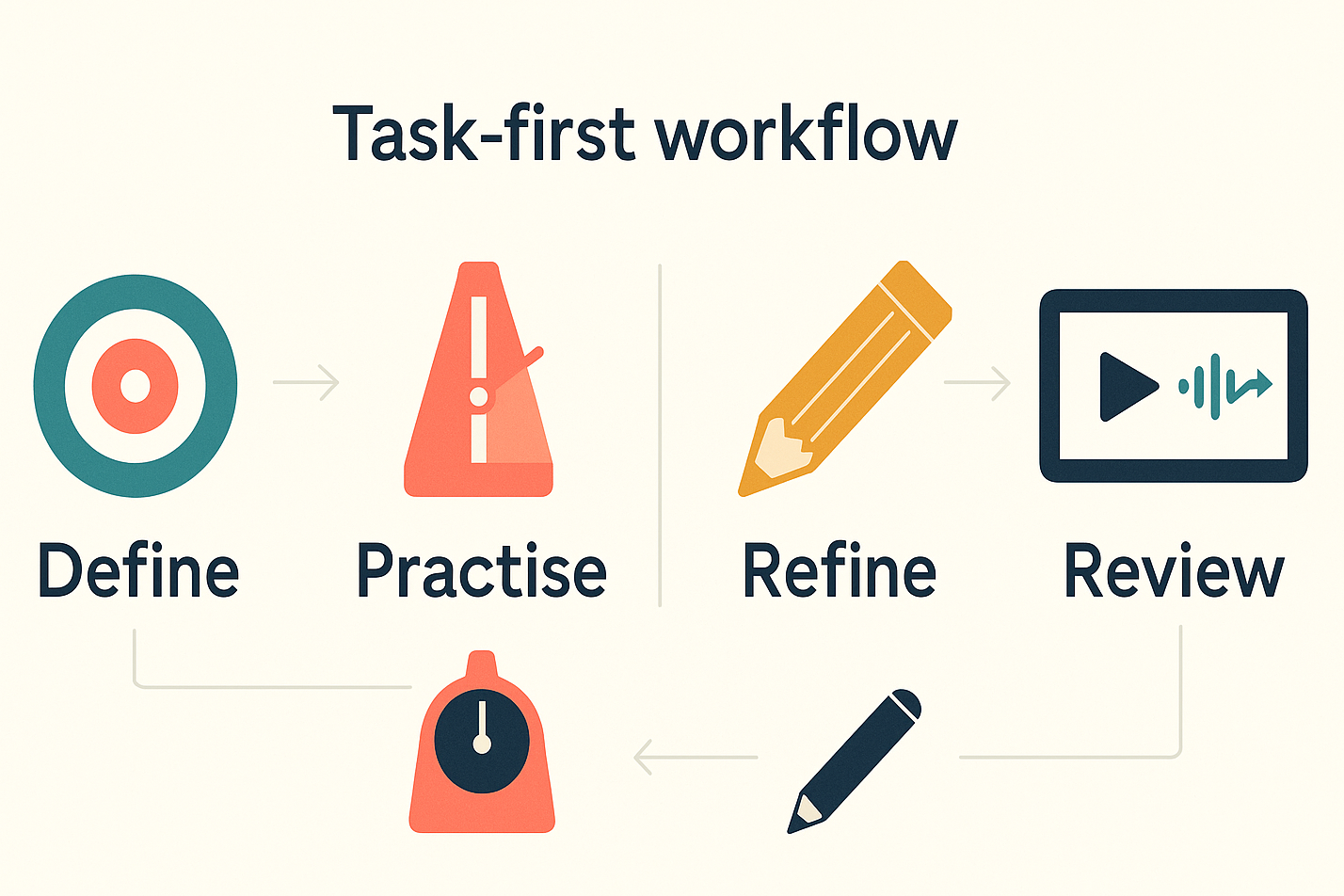A Task-First Approach to Clarinet Practice
Forget the stopwatch. What counts is what’s better when you pack up. A task-first approach turns practising into clear wins you can actually hear: one goal, the right tool, a quick check, then move on.
Research into deliberate practice (Ericsson) and motor learning (Schmidt & Lee; Wulf) backs this up: focused goals and timely feedback beat long, unfocused sessions.
In this article I’ll show you how to plan a short, smart routine, measure what changes, and refine it so every session, whatever its length, feels productive and genuinely meaningful.
Why Tasks Beat Time
When you plan practice, it’s easy to only think of it as time spent. However, simply clocking hours generally leads to rewarding endurance rather than actually seeing improvement. This is why adopting a task-oriented mindset helps you to clearly define what will change and how you’ll know.
For example: “Today’s goal: clean B-flat to B slurs across the break at ♩=60 with eight out of ten reps, no wobbles.
That’s specific and testable.
Set One Clear Objective
Write down a specific focus, note how you’ll measure it and what tools you’ll use for accurate feedback:
Use a single-sentence brief:
Focus: skill + context (e.g., “Right-hand position and seal in chalumeau long tones”).
Metric: Metric: tempo, reps, or quality of control.
Feedback: how you’ll check (recording, tuner/drone, mirror).
Structure Your Time
30, 45, or 60 minutes
Tone & Air: 5 min
Long-tones with a drone (G3–G4), crescendo–decrescendo, embouchure steady.Finger Fluency and Articulation: 10–20 min
Scales, Arpeggios, Thirds or a pattern that serves today’s objective.Repertoire: 10–20 min
Eight bars of repertoire where the skill must hold.Review: 5 min
Record, listen once, write one line: What changed? What’s tomorrow’s task?
Practice Methods That Work
A good session isn’t about minutes on the clock; it’s about one clear change you can hear. Use the methods below to set a goal, test it, and carry the improvement into your music.
‘Chunking’ or Section Practice
Task: Break a passage into small, repeatable groups; master each chunk before joining them.
How: Start slurred at a comfortable tempo, then add rhythm and articulation. Pencil in the groups on your part. Learn more →
Tools: Metronome; pencil.
Intentional Repetition
Task: Loop a tiny passage with one clear objective.
How: Focus on a single area of your technique with each repetition, i.e. rhythm, tone, articulation, Finger fluency, breathing, posture then reinforce (repeat) the accurate version. Learn more →
Tools: Metronome; notebook/phone.
Legato Training - 5ths & 12ths
Task: Smooth register shifts from the chalumeau to the clarion (e.g., B–E–B / C–F–C and ascend chromatically). Download the exercise HERE.
How: Breathe out before you inhale. Start with a clear and focused sound and maintain consistent airstream and embouchure support as you depress the register key to connect the chalumeau to the clarion. Tip: reinforce the chin downward (away from the reed) as you ascend to the note in the clarion register.
Tools: Metronome and Tuner.
Distance Training - Articulation
Task: Aim to achieve a gentle contact and release of the tongue without any percussive attack or “wobbles”. Download the exercise HERE.
How: Begin by sounding a minim, then without stopping the tone, lightly touch the reed with the tip of your tongue just below the reed tip for another minim; keep the embouchure steady and the air well supported, and you’ll notice a small drop in pitch. Aim for the smoothest contact and release (no percussive attack), then repeat the pattern up the chromatic scale.
Tools: Metronome.
Active Listening
Test tone, legato, articulation and intonation deliberately. Use a drone to find pitch centre; compare takes and adjust. Learn more →
Tools: TonalEnergy Tuner & Metronome (TE Tuner) is a fantastic app for working with Drones. You can also record playing and listen back with a Zoom recording device.
Why these work
Small wins, often. Short, regular practice builds real muscle memory and quiet confidence. Ten focused minutes most days beats a once-a-week marathon.
Mix it up across the week. Rotate your focus to tone, fingers, articulation, intonation so skills stick and you can see which methods actually move the needle.
Think about the sound. Aim to “fill the room” with a clear and centred tone. An external focus like this often produces better results than micromanaging embouchure.
Task-oriented clarinet practice techniques turn minutes into outcomes. Set one goal, measure it with the right tool, then carry that change straight into your music.
Happy practising!
References
ABRSM. (2020). Performance grades: Guidance for candidates and teachers. ABRSM.
Bjork, R. A., & Bjork, E. L. (2011). Making things hard on yourself, but in a good way: Creating desirable difficulties to enhance learning. In M. A. Gernsbacher, R. W. Pew, L. M. Hough, & J. R. Pomerantz (Eds.), Psychology and the real world: Essays illustrating fundamental contributions to society (pp. 56–64). Worth Publishers.
Chaffin, R., Imreh, G., & Crawford, M. (2002). Practicing perfection: Memory and piano performance. Lawrence Erlbaum Associates.
Ericsson, K. A., Krampe, R. T., & Tesch-Römer, C. (1993). The role of deliberate practice in the acquisition of expert performance. Psychological Review, 100(3), 363–406.
Green, B., & Gallwey, W. T. (1986). The inner game of music. Doubleday.
Harris, P. (2015). Simultaneous learning: The definitive method. Faber Music.
Schmidt, R. A., Lee, T. D., Winstein, C. J., Wulf, G., & Zelaznik, H. N. (2019). Motor control and learning: A behavioral emphasis (6th ed.). Human Kinetics.
Wulf, G. (2013). Attentional focus and motor learning: A review of 15 years. International Review of Sport and Exercise Psychology, 6(1), 77–104.
Wulf, G., & Lewthwaite, R. (2016). Optimizing performance through intrinsic motivation and attention for learning: The OPTIMAL theory of motor learning. Psychonomic Bulletin & Review, 23(5), 1382–1414.



